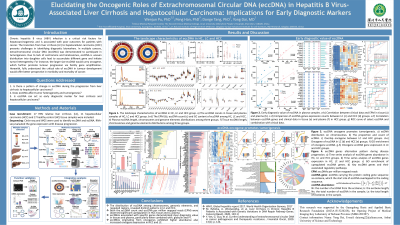Tuesday Poster Session
Category: Liver
P4627 - Elucidating the Oncogenic Roles of Extrachromosomal Circular DNA (eccDNA) in Hepatitis B Virus-Associated Liver Cirrhosis and Hepatocellular Carcinoma: Implications for Early Diagnostic Markers
Tuesday, October 29, 2024
10:30 AM - 4:00 PM ET
Location: Exhibit Hall E

Has Audio

Wenjun Pu, PhD
The Second Clinical Medical College (Shenzhen People's Hospital), Jinan University
Shenzhen City, Guangdong, China (People's Republic)
Presenting Author(s)
Award: Presidential Poster Award
Wenjun Pu, PhD, Donge Tang, PhD, Yong Dai, MD, PhD
The Second Clinical Medical College (Shenzhen People's Hospital), Jinan University, Shenzhen City, Guangdong, China
Introduction: Chronic hepatitis B virus (HBV) infection is a critical risk factor for hepatocarcinogenesis and is associated with poor outcomes for patients with cancer. The transition from liver cirrhosis (LC) to hepatocellular carcinoma (HCC) presents challenges in identifying diagnostic biomarkers. The role of extrachromosomal circular DNA (eccDNA) in driving tumorigenesis remains poorly understood, particularly in HBV-associated liver cirrhosis and cancer.
Methods: This study aimed to elucidate the oncogenic roles of eccDNA and its functional contributions to tumor progression in HBV-related LC and HCC, with the potential to identify early diagnostic markers. Our approach involved profiling plasmas and tissues from HBV-infected cirrhosis (n=17), HBV-infected HCC (n=11), and healthy controls (HC, n=17) using circle-seq, whole-genome sequencing, and bulk RNA sequencing to evaluate eccDNA distribution and functions in LC and HCC. Machine learning was employed to screen eccDNA with diagnostic potential. Furthermore, outward PCR and in vitro synthesis targeted eccDNA were used to validate its role in tumorigenesis.
Results: The results fully characterized the distribution of eccDNA among chromosomes, genomic elements, and repeated regions, revealing distinct patterns in HCC and LC. Both the eccDNA count and eccDNA per million mapped reads (EPM) were observed significant upregulation in HCC tissue and LC plasma. Most eccDNAs exhibited lengths less than 1 kb, with dual peaks (230 bp, 380 bp) and triple peaks (380 bp, 620 bp, 750 bp) in plasma and tissue, respectively. eccDNAs associated with specific genes demonstrated clear diagnostic value in tissues (AUC >0.8) and plasma (AUC >0.85), particularly when combined with globulin and plasma prothrombin time. Additionally, eccDNAs originating from oncogenes exhibited higher abundance and also increased oncogene expression in HCC and LC. Validation via synthesis eccDNA confirmed its oncogenic role in promoting oncogene expression.
Discussion: The higher abundance of eccDNA in HCC group indicated genomic alterations and enriched in the tumors, which drove tumorigenesis. Our findings illuminate the diagnostic potential of eccDNA in hepatitis B virus-related cirrhosis and cancer, offering insights into early detection strategies and therapeutic interventions.

Disclosures:
Wenjun Pu, PhD, Donge Tang, PhD, Yong Dai, MD, PhD. P4627 - Elucidating the Oncogenic Roles of Extrachromosomal Circular DNA (eccDNA) in Hepatitis B Virus-Associated Liver Cirrhosis and Hepatocellular Carcinoma: Implications for Early Diagnostic Markers, ACG 2024 Annual Scientific Meeting Abstracts. Philadelphia, PA: American College of Gastroenterology.
Wenjun Pu, PhD, Donge Tang, PhD, Yong Dai, MD, PhD
The Second Clinical Medical College (Shenzhen People's Hospital), Jinan University, Shenzhen City, Guangdong, China
Introduction: Chronic hepatitis B virus (HBV) infection is a critical risk factor for hepatocarcinogenesis and is associated with poor outcomes for patients with cancer. The transition from liver cirrhosis (LC) to hepatocellular carcinoma (HCC) presents challenges in identifying diagnostic biomarkers. The role of extrachromosomal circular DNA (eccDNA) in driving tumorigenesis remains poorly understood, particularly in HBV-associated liver cirrhosis and cancer.
Methods: This study aimed to elucidate the oncogenic roles of eccDNA and its functional contributions to tumor progression in HBV-related LC and HCC, with the potential to identify early diagnostic markers. Our approach involved profiling plasmas and tissues from HBV-infected cirrhosis (n=17), HBV-infected HCC (n=11), and healthy controls (HC, n=17) using circle-seq, whole-genome sequencing, and bulk RNA sequencing to evaluate eccDNA distribution and functions in LC and HCC. Machine learning was employed to screen eccDNA with diagnostic potential. Furthermore, outward PCR and in vitro synthesis targeted eccDNA were used to validate its role in tumorigenesis.
Results: The results fully characterized the distribution of eccDNA among chromosomes, genomic elements, and repeated regions, revealing distinct patterns in HCC and LC. Both the eccDNA count and eccDNA per million mapped reads (EPM) were observed significant upregulation in HCC tissue and LC plasma. Most eccDNAs exhibited lengths less than 1 kb, with dual peaks (230 bp, 380 bp) and triple peaks (380 bp, 620 bp, 750 bp) in plasma and tissue, respectively. eccDNAs associated with specific genes demonstrated clear diagnostic value in tissues (AUC >0.8) and plasma (AUC >0.85), particularly when combined with globulin and plasma prothrombin time. Additionally, eccDNAs originating from oncogenes exhibited higher abundance and also increased oncogene expression in HCC and LC. Validation via synthesis eccDNA confirmed its oncogenic role in promoting oncogene expression.
Discussion: The higher abundance of eccDNA in HCC group indicated genomic alterations and enriched in the tumors, which drove tumorigenesis. Our findings illuminate the diagnostic potential of eccDNA in hepatitis B virus-related cirrhosis and cancer, offering insights into early detection strategies and therapeutic interventions.

Figure: The schematic diagram of workflow.
Disclosures:
Wenjun Pu indicated no relevant financial relationships.
Donge Tang indicated no relevant financial relationships.
Yong Dai indicated no relevant financial relationships.
Wenjun Pu, PhD, Donge Tang, PhD, Yong Dai, MD, PhD. P4627 - Elucidating the Oncogenic Roles of Extrachromosomal Circular DNA (eccDNA) in Hepatitis B Virus-Associated Liver Cirrhosis and Hepatocellular Carcinoma: Implications for Early Diagnostic Markers, ACG 2024 Annual Scientific Meeting Abstracts. Philadelphia, PA: American College of Gastroenterology.

